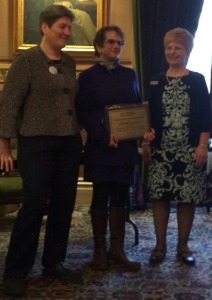
Last week, I was recognized for my work with a 2016 Restorative Justice Communicator Award, presented by the Community Justice Network of Vermont.
The story is at the center of the Restorative Justice process, and as a volunteer for the Brattleboro Restorative Justice Center, I’ve listened to a lot of stories.
These are real-life stories, often dramatic, sometimes emotionally wrenching, and at their best, transformative.
Engaging with these particular stories is one of the best examples I know of how powerful a personal story can be, how empowering telling that story can be, and how adversaries can find common ground, settle conflict, and make positive changes by telling and listening to each other’s stories.
While I’ve always wanted to tell important stories, it is this work that has taught me how telling stories can create change. So I’ve been writing about Restorative Justice for almost ten years, including on this blog.

Restorative Justice keeps offenders out of the criminal justice system and brings them back into the community. (pixabay)
I’ve spread the word about Vermont’s widespread use of Restorative Justice in the place of punishment. Restorative Justice keeps offenders out of the criminal justice system and brings them back into the community. Studies repeatedly show that this approach reduces recidivism, strengthens communities, increases safety, reduces costs, and promotes active citizenship – all things I support.
The criminal justice system focuses on the offender, often to the neglect of the victim. Restorative Justice includes the victim in the process. In RJ, victims of crime have a voice in a facilitated dialogue with the person who harmed them. I know. Last summer I was a victim. Restorative Justice allowed me to tell my story to the offender. I told him how he made me feel unsafe and what he could do to help change that.
RJ gave this offender a chance to “make it right” – which was much more effective than putting him in jail.

The Vermont Statehouse, Montpelier.
I’ve also learned how to apply restorative practices within my own life – to the betterment of my marriage, my mothering, my friendships and all the other relationships in my life. Because I believe so strongly in the benefits of restorative practices, I’ve written about Vermont’s leadership in the field – a lot. I wrote because not only does RJ rely on storytelling, but so does my livelihood. I believe in “advancing issues through narrative; telling stories to create change.”
Last week, I was recognized for my work with a 2016 Restorative Justice Communicator Award, presented by the Community Justice Network of Vermont. I went to Montpelier and picked up my plaque in a ceremony at the statehouse.

Mary Pipher’s inspiring book, Writing to Change the World.
I’m honored – and humbled. Establishing Restorative Justice within Vermont’s Department of Corrections is the work of visionaries whose leadership and dedication developed the program and convinced the politicians to support it. In Vermont, RJ relies on volunteers; I’m one of over a thousand.
But I’m also a writer whose job is to tell stories that matter, and it’s lovely to be recognized for this work. This recognition serves as both a reminder and as encouragement to keep writing to change the world.

Deborah Lee Luskin,
M. Shafer, Photo
Deborah Lee Luskin is a novelist, essayist and educator. Learn more at www.deborahleeluskin.com

Congratulations on your award! It sounds like very rewarding work.
Thanks! Restorative Justice is to criminal justice what local food is to industrially processed calories – and it’s based in narrative – all things I’m passionate about.
Congrats…and thank you for introducing me to Mary Pipher (via this post)…it is timely for me.
Thank you! I found Pipher’s book so inspiring – and I reread her chapter on speech-making every time I have to give one. Wishing you powerful words.
Congratulations! What a wonderful project to be involved with, too; it sounds like it can make such a profound difference in people’s lives.
Thanks! Yes, RJ can and does often make a profound difference in people’s lives. And sometimes, we don’t know the impact we have – sometimes, it comes long after the fact, but our words and stories do get under the skin and incubate there.
Deborah, you work is amazing. i agree with you that our stories are the greatest tool we have that we could use to transform the world into a better place. i am so thrilled to learn that there are people who are working on restoring dignity of those perceived to be less human just because they committed an offense. i concur with you that these people should be treated with care for that is what #socialjustice demand from us.
Deborah, for two years, i have written on social justice, but today is special to me because i have found your blog and i am have to report to you that I easily relate to what you have because the topic speak of what is close to my heart
I would like to re blog some of you articles but with you permission. kindly advice me on this.
Finally Deborah from Nairobi i wish to congratulate you for winning the award from the community Justice Network of Vermont
Hello, Shadrack Agaki! Thank you for your kind note. You certainly have permission to reblog my posts. I do ask that you give credit both to me (the author) and to the publisher (this one would be nhwn.wordpress.com; others can be found on vpr.net). Can you send me links to your articles on social justice? I’d like to read what’s going on in Kenya. You can send me a private message through my website’s Contact Me page. Thanks for reaching out, Deborah.
Thanks Deborah, in Kenya we say Karibu- (welcome)
Congratulations! That is a wonderful award. Keep up the good work. You are an inspiration.
Thanks! The irony, of course, is that I’ve been working and dreaming about fame and fortune in a completely different arena, so this award is a real wake-up call about reality v. fantasy and what “good work” can be!
Exactly.
Congratulations on your award! Being involved in this kind of project must be exciting.
Thanks. RJ requires real “thought work” and digging deep down into core beliefs while remaining open to others’ different experiences and beliefs. It is what makes for strong communities where people agree to commons standards of community behavior while maintaining the right to think for themselves. It is the bedrock of a truly open and democratic society. And yes, I find this exciting.
Congratulations! You are an inspiration. Keep it up!
Thank you. I’m glad if all my work does is make other aware of alternatives to punitive measures; if it inspires someone to act – either to write (about any issue about which their passionate) or to volunteer for a cause, or to promote social justice in their world, so much the better. Good luck!
Congratulations! So inspiring.
Thank you. Please see my comment above regarding inspiration.
As writers and community members, we have the potential to inspire others without even knowing it. Each of us has the capacity to inspire. Good luck!
Congratulations! This is amazing work you do!
Congratulations on your award! I’m eager to read that book… 🙂